|
|
| | ||||||||
Ask anybody over thirty-five what they know about Cambodia and the most likely answer will be "Pol Pot", especially if they recall the The Dead Kennedys' unholy 1980 cult hit. On the other hand quiz someone younger, and you're more likely to turn up "Lara Croft" or "Tomb Raider".
Cambodia, sometimes known as Kampuchea, certainly has a chequered and tragic past extending, not just back to the late 20th Century, but hundreds of years to the time of the enigmatic Khmers and earlier.
 The
legacy of Cambodia's tumultuous history is evident throughout the country in numerous
and various ways. For a first-time visitor like myself, the most obvious first
impression is the recovering infrastructure, clawing its way out of the "year
zero" nightmare inflicted on it during the insanity of the Khmer
Rouge regime of the late '70s. Clumsy rickshaws, rickety carts and smoky old
mopeds all compete for space with modern Toyota 4WDs and sleek minibuses on the
inadequate, dusty roads. And through intricate and expressive stone-masonry, Cambodia's
abundant archaeology tells vivid tales of savage conflict and regal intrigue.
The
legacy of Cambodia's tumultuous history is evident throughout the country in numerous
and various ways. For a first-time visitor like myself, the most obvious first
impression is the recovering infrastructure, clawing its way out of the "year
zero" nightmare inflicted on it during the insanity of the Khmer
Rouge regime of the late '70s. Clumsy rickshaws, rickety carts and smoky old
mopeds all compete for space with modern Toyota 4WDs and sleek minibuses on the
inadequate, dusty roads. And through intricate and expressive stone-masonry, Cambodia's
abundant archaeology tells vivid tales of savage conflict and regal intrigue.
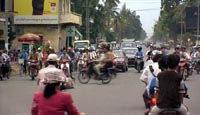 Even
in the capital of Phnom Penh, the city streets are only now being treated to a
layer of bitumen where the newly mobile are helping to create an air of bustle
and activity. Once a virtual ghost town under the iron fist of the KR, Phnom Penh
is blossoming again into a mini-metropolis with all the trappings of a vibrant
SE Asian hub.
Even
in the capital of Phnom Penh, the city streets are only now being treated to a
layer of bitumen where the newly mobile are helping to create an air of bustle
and activity. Once a virtual ghost town under the iron fist of the KR, Phnom Penh
is blossoming again into a mini-metropolis with all the trappings of a vibrant
SE Asian hub.
After spending some time observing the quiet chaos in the downtown districts, the distinct lack of older folks becomes evident. This fact is even more apparent when you travel into the rural heartland. During the mayhem of the '70s and '80s, the population of Cambodia was almost halved through war, genocide, disease and starvation, leaving barely four million inhabitants to rebuild the shattered land. Some twenty years later, over ten million people are now dispersed across the countryside, with a demographic distinctly skewed to the under-25s. A visit to either the infamous 'killing fields' or the macabre prison museum leaves one in no doubt about the deplorable acts perpetrated on this hapless community.
Timber and tourism now make up the bulk of Cambodia's foreign trade, with the latter being particularly enthusiastically embraced by the populace.
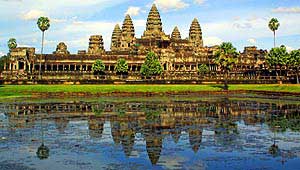 The
country's key attraction, the Angkor Wat complex near Siem Reap is driving the
turnaround almost single-handedly. Rediscovered by French colonialists in the
mid-1800s, the huge temples were soon cleared of hundreds of years of jungle growth
and revealed in their entirety. Apart from the widely-known Angkor Wat, (it's
on the flag) a dozen or more impressive temples come together to make up an enormous
fortress city around the central complex of Angkor Thom.
The
country's key attraction, the Angkor Wat complex near Siem Reap is driving the
turnaround almost single-handedly. Rediscovered by French colonialists in the
mid-1800s, the huge temples were soon cleared of hundreds of years of jungle growth
and revealed in their entirety. Apart from the widely-known Angkor Wat, (it's
on the flag) a dozen or more impressive temples come together to make up an enormous
fortress city around the central complex of Angkor Thom.
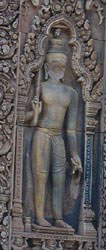 This
thriving, ornate city was the seat of power for some twenty-seven Khmer kings
from 802 AD until around 1327 and finally abandoned to the jungle one hundred
years later. For over four centuries Angkor lay dormant under its verdant shroud,
and the damage to its intricate structures during this time was enormous. Huge
Banyan trees, still evident at Lara Croft's temple (Ta Prohm), took root amongst
the ruins, prising apart walls and foundations. Historians and archaeologists
have been trying to put the heritage and the stonework back together for nearly
one hundred years, their efforts continually thwarted by war, vandalism and looting.
This
thriving, ornate city was the seat of power for some twenty-seven Khmer kings
from 802 AD until around 1327 and finally abandoned to the jungle one hundred
years later. For over four centuries Angkor lay dormant under its verdant shroud,
and the damage to its intricate structures during this time was enormous. Huge
Banyan trees, still evident at Lara Croft's temple (Ta Prohm), took root amongst
the ruins, prising apart walls and foundations. Historians and archaeologists
have been trying to put the heritage and the stonework back together for nearly
one hundred years, their efforts continually thwarted by war, vandalism and looting.
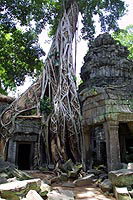 Further
supporting its significance, UNESCO
listed Angkor as a World Heritage area in 1992, acknowledging the 400 square kilometre
Angkor Archaeological Park as one of the most significant such sites in SE Asia.
At the same time it was inscribed on the List
of World Heritage in Danger.
Further
supporting its significance, UNESCO
listed Angkor as a World Heritage area in 1992, acknowledging the 400 square kilometre
Angkor Archaeological Park as one of the most significant such sites in SE Asia.
At the same time it was inscribed on the List
of World Heritage in Danger.
Shortly after UNESCO's blessing, the final pockets of Khmer Rouge were dissolved, removing the single greatest obstacle to the return of tourists, and in just ten years, visitor numbers are soaring. In 1998 nearly 50,000 visited Angkor. This year (2002) well over 200,000 are expected, with the trend continuing steeply upward. Some predict this figure will top 1,000,000 annually before 2005.
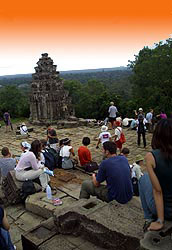 This
latest foreign invasion is placing enormous stress, not only on the structures
themselves as tanned, sandalled rock hoppers scramble over the ancient pavilions,
but on the local villagers and infrastructure too. Sewage systems are over-stressed
and water supply is well short of the mark. Wranglings are brewing too amongst
local merchants, vendors and transport operators as concessions are gifted to
foreign operators. UNESCO proposes to ban all petrol vehicles within the immediate
Angkor precinct, instead bringing in a foreign-owned fleet of electric buggies.
This
latest foreign invasion is placing enormous stress, not only on the structures
themselves as tanned, sandalled rock hoppers scramble over the ancient pavilions,
but on the local villagers and infrastructure too. Sewage systems are over-stressed
and water supply is well short of the mark. Wranglings are brewing too amongst
local merchants, vendors and transport operators as concessions are gifted to
foreign operators. UNESCO proposes to ban all petrol vehicles within the immediate
Angkor precinct, instead bringing in a foreign-owned fleet of electric buggies.
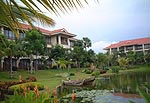 Under
the banner of "Ancient Heritage, French Perfection" the huge Accor group
recently opened their opulent five-star Sofitel
Royal Angkor Resort, replete with 239 rooms, five restaurants, pools, bars
and health facilities; indeed, a monument to extravagance rivalling the mighty
Wat itself. With some measure of altruism, Accor co-founder, Paul Dubrule, put
US$1million of his own money on the table to establish a hotel and hospitality
school to supply, not only Accor's requirements, but the wider Siem Reap region.
Topped up by UNESCO and government contributions, the Paul Dubrule Hotel School
will open in early 2003.
Under
the banner of "Ancient Heritage, French Perfection" the huge Accor group
recently opened their opulent five-star Sofitel
Royal Angkor Resort, replete with 239 rooms, five restaurants, pools, bars
and health facilities; indeed, a monument to extravagance rivalling the mighty
Wat itself. With some measure of altruism, Accor co-founder, Paul Dubrule, put
US$1million of his own money on the table to establish a hotel and hospitality
school to supply, not only Accor's requirements, but the wider Siem Reap region.
Topped up by UNESCO and government contributions, the Paul Dubrule Hotel School
will open in early 2003.
"The
Sofitel Royal Angkor employs almost five hundred local workers and contributes
to the restoration of the Bat Choum Temple here in Angkor via UNESCO," says
General Manager, Philippe Bissig.
In
the midst of this burgeoning prosperity, pessimists could still be drawn to wonder
when the ubiquitous "golden arches" and famous colonel will preside
over the nearby shopping and market precinct, neatly completing the multinational
transition. Clearly the delicate remnants of the famous walled city are facing
yet another crisis.
Cambodia,
after its massive political and economic reboot twenty years ago, is bouncing
back so rapidly in some areas that it risks an unhealthy backlash. The precarious
balance between economic growth, foreign investment, community involvement and
environmental security is yet to be properly addressed. Local Cambodians, quite
understandably, are keen to catch this veritable tsunami of prosperity, but will
it sweep past them, or will they ride it to ruin?
"Urgent steps have to be taken" said Hervé Barré of UNESCO's Cultural Policies Division at a recent international cultural tourism conference, "through a global approach to conservation and development of this heritage by promoting good-value tourism that involves local people and preserves the site at the same time."
One Australian adventure travel company, Peregrine, maintains a rigorous policy of local involvement and participation. Peregrine trains and employs local guides and ensures their activities contribute to the host country's economy whilst educating tourists in tradition and economic needs at a 'grass roots' level.
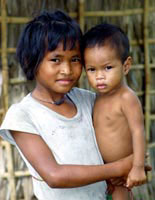 All
the above considered, one cannot help but be touched by the humble serenity of
Cambodia's largely Buddhist population. Even the perennial street hawkers are
polite and cheerful and, as a result, difficult to unhook. The food is delightful,
falling somewhere between the robust flavours of Thai and the adventurous palate
of Vietnamese. Everyone accepts, even prefers, the US dollar and satisfactory
hotels are not hard to find. Most importantly, at the end of a hard day temple-tramping,
a soothing Angkor Draft is never far away.
All
the above considered, one cannot help but be touched by the humble serenity of
Cambodia's largely Buddhist population. Even the perennial street hawkers are
polite and cheerful and, as a result, difficult to unhook. The food is delightful,
falling somewhere between the robust flavours of Thai and the adventurous palate
of Vietnamese. Everyone accepts, even prefers, the US dollar and satisfactory
hotels are not hard to find. Most importantly, at the end of a hard day temple-tramping,
a soothing Angkor Draft is never far away.
As I survey the receding expanse of rice paddies through the aircraft window, my only lingering concern is whether the full benefit of the resurgent economy will eventually flow to the patient, ever-tolerant people of Cambodia. Or will they continue to peer longingly into the windows of the tour buses wondering when their day will arrive?
| Fact File Vietnam Airlines flies twice daily to both Phnom Penh and Siem Reap from Saigon (Ho Chi Minh City) and daily to Phnom Penh from Hanoi. VN also flies direct from both Melbourne (2/week) and Sydney (3/week) to Saigon. Peregrine
Adventures operates Gecko's Cambodia and Ancient Angkor. 6 days
Phnom Penh to Siem Reap. Departs fortnightly year round and costs A$695, land
only.
IMPORTANT DISCLAIMER: Cambodia is still a recovering country with numerous potential hazards. The author does not recommend unescorted travel or travel to remote locations. Please familiarise yourself with current travel advice by regularly visiting the Department of Foreign Affairs website. Further
Reading: CIA
Factbook: Cambodia |
More travel stories by Rod Eime
Background by Runic Designs
| | |